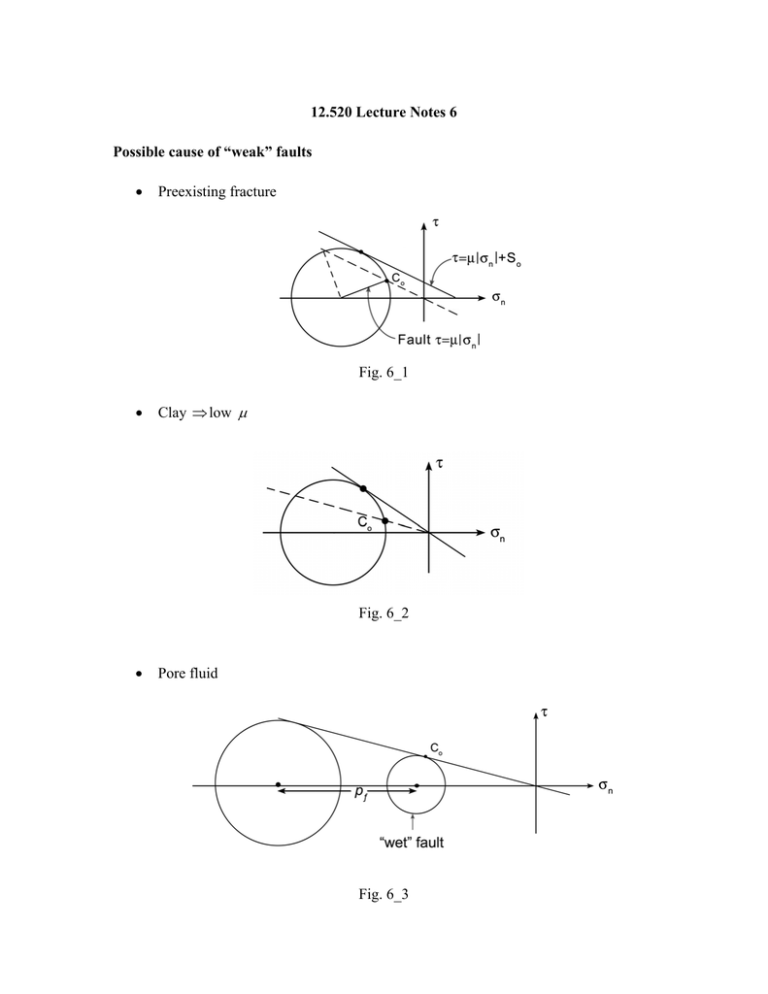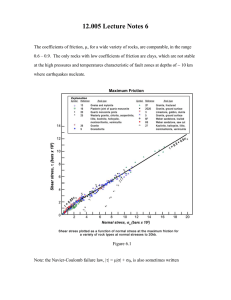12.520 Lecture Notes 6 Possible cause of “weak” faults
advertisement

12.520 Lecture Notes 6 Possible cause of “weak” faults • Preexisting fracture Fig. 6_1 • Clay ⇒ low µ Fig. 6_2 • Pore fluid Fig. 6_3 How to get quantitative graphs? Make assumption! Zoback et al example. Fig. 6_4 Assume σ c constant. τ fault = c0 . Given β , c0 , σ r get α . Question: In far field, σ 12 = cF . On fault σ 12 = c0 . ∂σ 12 ∂x1 > 0 -- How can this be? Another approach: Assume σ τ ≡ c0 , find σ r given α . Fig. 6_5 Pore fluid pressure model of fault weakening Fig. 6_6 Fault zone highly permeable Darcy flow ≈ heat flow Permeability ≈ conductivity p≈T Given source of water High permeability ⇒ high p Fig. 6_7 Question: • What are implication for stress direction in fault zone? • Is low ∆σ in fault zone consistent with large ∆σ outside? Fig. 6_8 Stress Rotation, after Zoback et al, 1987 The principal stress directions are observed to rotate in the vicinity of the San Andreas fault (SAF). In the far-field (e.g., Nevada), the maximum compressive stress is oriented at an angle to the fault trace β ~ 55°. But in the near field, this angle, now called α, is close to 85°. (Note that this is the same as the angle between the least compressive stress and the normal to the fault plane, the angle conventionally used in Mohr circle analysis.) Assume that in the far-field stress has σI = -68 MPa, σII (assumed vertical and lithostatic) = -136 MPa, and σIII = -204 MPa. (What style of faulting would this cause?) Assume that the fault has strength C0, so that σ12 becomes smaller approaching the fault. (How could this happen, given Newton's second law?). Also assume that the normal stress across the fault maintains its far-field value (σ22 in the coordinate system fixed to the fault, as shown in the diagram). Assume that σc remains the same. (Does this agree with the style of faulting and the folding near the SAF?) Then, from a Mohr's circle construction, it is straightforward to obtain a relation between α and β. Fig. 6_9 The coefficients of friction, µ, for a wide variety of rocks, are comparable, in the range 0.6 – 0.9. The only rocks with low coefficients of friction are clays, which are not stable at the high pressures and temperatures characteristic of fault zones at depths of ~ 10 km where earthquakes nucleate. data from Byerlee, Pageoph, 116, 1978 Fig. 6_10 Note: the Navier-Coulomb failure law, |τ| = µ|σ| + σ0, is also sometimes written |τ| = µ|σ| + S0. For rocks, S0 ~ 0.1 - 4 kbars (10 - 400 MPa). How does this "breaking strength compare with the "frictional stress?" Plot stress predicted for the initiation of faulting as a function of depth, assuming that σ is the lithostatic stress. (Recall that the "lithostatic stress gradient ~ 1 kbar/3 km.) Fig. 6_11 So, if Byerlee's law is correct, and if the stress in the lithosphere is not too far from lithostatic, the shear stress on faults should be ~5 kbar at 15 km depth and about 250 kbar at 700 km depth. Fig. 6_12 How can we test this prediction? • Model stresses associated with holding up mountains (e.g., Himalayas > 1.5 kbar) • Stress drops associated with earthquakes (usually ~ 3- 300 bars, very rarely > 1 kbar) • Work available from convection (dynamic "engine," <~1 kbar • Heat flow in fault zones (frictional heating rate ~ τv => τ ~ 100 bars Big discrepancies here - a frontier region of geodynamics. Important factor - the role of pore fluid pressure in faults. Empirical results: For a pore fluid pressure p, the Navier-Coulomb failure law becomes: |τ| = µ|σ+p| + S0 (Note that because compressive pressure is positive, while compressive normal stress σ is negative, the pressure decreases the amplitude of the "effective normal stress" |σ+p|.) Graphically: Fig. 6_13 A qualitative explanation of the effect of pore fluid pressure is that the the fluid helps to "support" some of the normal stress that is otherwise carried by solid grains. Consider a simple model of a continuum made up of dry sand. Let fA represent the fraction of a surface area that is made up of solid grain contacts. Then for a macroscopic normal stress σ, the average (microscopic) normal stress at the solid grain contacts is σ/fA, since the pore space in between can support no normal tractions. (Of course, in places the actual value will be much larger than the average value.) If Admonton's law applies to the contacts, then the microscopic shear traction needed to cause failure is µσ/fA, and the macroscopic shear traction is τ=µσ. If pore fluid pressure is now introduced, the pore fluid will support some of the macroscopic normal stress, leading to a decrease to the normal stress at the grain contacts. Fig. 6_14 Adding pore fluid pressure effectively "stretches" the σn axis, giving, effectively, a lower coefficient of friction (except that angles no longer work out!) Fig. 6_15 An alternative explanation for deep earthquakes is that the failure envelope bends over at large σn. Fig. 6_16 Finally, let's consider a medium that is anisotropic – perhaps one which has a preexisting fracture at an angle θ to the least principal stress. (For a preexisting fracture, the strength S0 = 0.) Then if the double angle 2θ is within the region shown, the rock will fail along the preexisting fracture. Fig. 6_17





